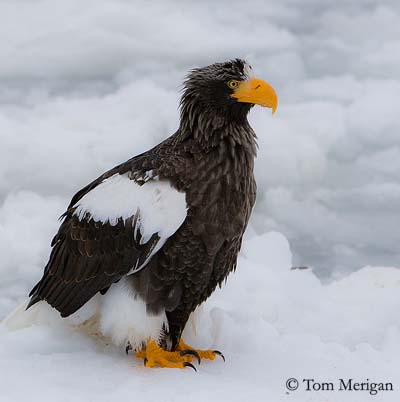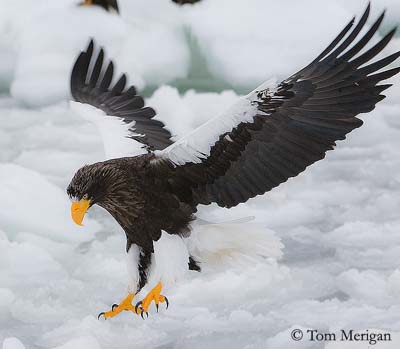
Steller’s Sea-Eagle
Haliaeetus pelagicus
Accipitriforme Order – Accipitridae Family
BIOMETRICS:
Length : 85-94 cm
Wingspan : 220-250 cm
Weight : M : 5-6 kg – F : 7-9 kg
DESCRIPTION:
Steller’s Sea-Eagle is one of the largest raptors in the world.
It is a powerful eagle with black and white plumage and huge beak.

Adult is very large. Plumage is blackish-brown overall, except on shoulders, rump, tail, thighs and forehead which are white. Tail is square-shaped and wings are broad.
The huge bill is strongly hooked and bright yellow. Eyes are yellow with narrow yellow eye-ring. Feet are bright yellow and armed with powerful black talons.

Both sexes are similar, but female is larger than male.
Juvenile is browner with buffy-white patches on scapulars and tail feathers. Bill is blackish. Eyes are dark brown.
It reaches its sexual maturity at 4-5 years, and the adult plumage at 8-10 years.
The race “niger”, Haliaeetus pelagicus niger, may be a dark morph with all black plumage except the white tail. It is sometimes considered as a species. It is named Korean Sea-Eagle. The Korean population is extinct, due to habitat loss and hunting.

VOICE:
Steller’s Sea-Eagle gives deep barking calls “ra-ra-rau-rau” and also loud gull-like sounds during the breeding season.

HABITAT:
Steller’s Sea-Eagle lives near water. It frequents coasts and forested valleys along rivers. This species nests near waters which provide them abundant and regular food resources. Nest-sites are often located near the river mouths, along sea-coasts, near lakes, and also on rocky coasts with high cliffs.
RANGE:
Steller’s Sea-Eagle lives in eastern Asia. It breeds exclusively in Russia, in the coastal regions along western Bering Sea, Sea of Okhotsk, and south of St Paul’s Bay.
Most of birds migrate southwards in winter to Ussuriland, Japan and Korea.
BEHAVIOUR:
Steller’s Sea-Eagle is a diurnal raptor, fishing during the day. Its preferred food is fish, mainly salmon and trout.
Its keen binocular vision allows it to detect the preys. The eagle waits and watches for prey from perch above water, between 5 and 30 metres high. It sweeps down and catches the fish with the talons.

It may also hunt while flying and circling 6-7 metres above water. It also may take small mammals and seabirds in the same way.

Steller’s Sea-Eagle is often seen standing on the ice and even in shallow water and sandbanks, grabbing fish as they swim by. It also steals food from other birds’ species or eagles, mainly when they are hunting in large flocks.

Steller’s Sea-Eagle performs courtship displays in late winter and female lays the eggs in mid-spring.
This large eagle is rare and poorly known, due to its primary habitat. It spends much of the warm season in the breeding range, and some of them are resident. But most of them migrate southwards during winter, to areas with open waters where food is abundant.

FLIGHT:
Steller’s Sea-Eagle performs powerful flight, thanks to the large wings. In spite of the size, this eagle is able to sweep down onto preys and to rise immediately, carrying the prey for eating it in dry location.

REPRODUCTION:
Breeding season occurs in April-May, but may vary according to the region, the weather conditions and the food resources.
Steller’s Sea-eagle builds a large nest at treetop or on cliff ledges. The nest is bulky and made with sticks. The nest-site is near water, in open site allowing the bird to have easy access to the nest.
Usually, the pair reuses the same nest year after year, adding materials before the laying, but they also may build a new airy. Sometimes, such nests are so heavy that the support breaks and the nest falls to the ground.

Female lays 1 to 3 eggs, but usually, only one chick survives, although sometimes, 2 or 3 chicks may be reared.
Incubation lasts about 38 to 45 days. At hatching, chicks are covered with white down, gradually changing to brown. They are fed on fish of 20-30 cm long.
The young fledge and learn to fly about 70 days after hatching. The chicks may fall from the nest, or even with it.
DIET:
Steller’s Sea-Eagle feeds mainly on fish (salmon and trout), alive or dead. It also takes small mammals and seabirds.
PROTECTION / THREATS / STATUS:
Steller’s Sea-Eagle is a RARE bird.
This eagle is protected by law, and is designated as National Treasure in Japan. Even low, numbers seem to be stable at this moment.
This species is threatened by degradation of the habitat, persecution and contamination of food sources in the southernmost parts of the range by chemicals from local industries.
The Steller’s Sea-Eagle was named for Georg Wilhelm Steller, an 18th century zoologist and explorer.

Fr: Pygargue de Steller
All : Riesenseeadler
Esp: Pigargo Gigante
Ital: Aquila di mare di Steller
Russe: Белоплечий орлан
Sd: Jättehavsörn
Photographs by Tom Merigan
His website:
Tom Meriganís Photo Galleries
Photographs by Jean Michel Peers
Son site : JMPN PHOTOGRAPHIE
Text by Nicole Bouglouan
Sources:
HANDBOOK OF THE BIRDS OF THE WORLD Vol 2 by Josep del Hoyo-Andrew Elliot-Jordi Sargatal - Lynx Edicions - ISBN: 8487334156
What Bird-The ultimate Bird Guide (Mitchell Waite)
Wikipedia (Wikipedia, The Free Encyclopedia)
